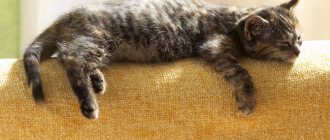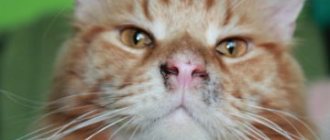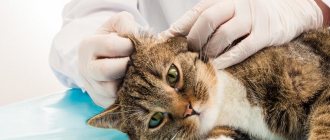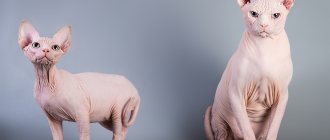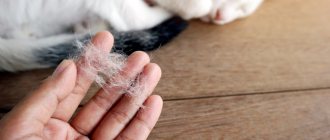Newborn kittens are always helpless: they still can’t see anything, they can’t hear well, they can’t walk or eat on their own. In addition, their thermoregulation has not yet developed; they need warmth.
If the cat dies, abandons the kittens, or refuses to feed them, the kittens may not survive. But if the newborn offspring falls, as they say, into the “good hands” of a person, the babies can be saved and raised.
What to do if you suddenly find yourself with a newborn kitten in your arms – we’ll tell you in the article.
Temperature regime for newborn kittens
It is necessary to feed orphaned kittens as early as possible, so that no more than a day passes after birth. But even more important is to keep them warm. Newborns cannot regulate their body temperature and are at risk of hypothermia outside their cozy den.
A heating pad will replace your mother's warm side. If you don’t have a special rubber heating pad, you can take a regular plastic bottle. The container is filled with boiling water and wrapped in a terry towel in several layers. This way the kitten will not get burned, and the water will cool more slowly. Depending on the temperature in the room, the hot water will have to be changed. In an apartment where it is about 20o, the heating pad keeps warm for about 6 hours. If the kittens are restless and huddle together, check the temperature of the heating pad.
For the first week, you should always have a heating pad on, change the water even at night. It becomes unnecessary when kittens reach one month of age. But knowing the love of cats for warmth, you can continue to apply the heating pad longer.
If there are a lot of kittens, then the box should be large. But then the blind kitten may get lost, bumping into the wall, and freeze. To prevent this from happening, you need to place bottles of hot water against each wall, and leave a free space in the center where the kittens can crawl. The cubs can simply snuggle up to the heating pad, or they can climb onto it and sleep on top.
Kittens weight gain
A kitten's weight gain is an important indicator of its health, growth and development. On average, a kitten should gain 10 g per day; kittens of large breeds (Maine Coon, Norwegian cat and others) can gain 15 g per day.
The kitten should be weighed every day until the age of 2 weeks, from 2 to 4 weeks - once every 3 days, then you can switch to weekly weighing until the end of the kitten's growth period. The weight of a kitten, as well as the rate at which it gains, depends on the expected weight of an adult animal, which is determined by its gender or breed.
Table: kitten body weight depending on its age
| Kitten age | Body mass |
| at birth | 60–160 g |
| 1 Week | 110–260 g |
| 2 weeks | 140–360 g |
| 3 weeks | 200–600 g |
| 4 weeks | 240–750 g |
| 2 months | 400–1700 g |
| 3 months | 1.0–2.5 kg |
| 4 months | 1.7–3.9 kg |
| 5 months | 2.2–5.5 kg |
| 6 months | 2.3–6.0 kg |
| 7 months | 2.4–6.5 kg |
| 8 months | 2.5–6.9 kg |
| 9 months | 2.5–7.0 kg |
| 10 months | 2.5–7.7 kg |
| 11 months | 2.5–8 kg |
| 12 months | 2.5–9 kg |
| Adult animal | 2.5–10 kg |
Setting up a den for newborn kittens
Even the tiniest, still blind kittens can scatter in search of their mother, food or a source of warmth. To avoid trouble, it is necessary to exclude the possibility of escaping from the “nest”. The traditional, time-tested option is a cardboard box. Newborn kittens will not soon be able to get out of it on their own. The box should not be a shoe box, but with high walls.
Cardboard is a warm and safe material, and if the box becomes unusable, you can simply throw it away and replace it with a new one. An alternative is a deep plastic box or container, but in this case the ventilation is worse, and the container itself will have to be washed and disinfected periodically.
Place bedding on the bottom. A convenient option is disposable absorbent diapers, but the downside is that it can bunch up and clump if you do not attach it with tape or an adhesive edge. Fleece has proven itself to be excellent - it dries quickly, is warm and soft. Woolen products are absolutely not suitable, although they are often placed on kittens for “entourage”. The claws may get tangled in the fur, causing injury to the kitten. In addition, babies acquire the bad habit of sucking wool and may swallow thread.
Hygiene procedures
In addition to nutrition, you should know other rules for caring for a newborn kitten. After eating, you can massage your cat's tummy clockwise with your fingers or the area under the tail, using a cotton pad soaked in water to empty the intestines.
Cats lick their cubs and try to keep their mouths, eyes, ears, and excretory organs clean. Wipe and wash the cat with warm and damp wipes, dry it so that it does not freeze after the procedures. Wash completely once a day in warm water.
The kitten needs a place to sleep and play at first. To begin with, a deep box is suitable, in which you need to lay soft bedding.
Cover your cat's area with old diapers or cut-up sheets so they can be easily washed or thrown away.
Is it possible to keep newborn kittens together?
If there are several kittens, they are usually kept together. This makes it easier for babies to stay warm by snuggling together. Living warmth and the presence of relatives calms and creates a feeling of security.
But there are exceptions to every rule. During the first week, kittens should not be left with each other unattended, as their umbilical cord has not yet healed. Up to the age of one month, observe how babies interact with each other. Without round-the-clock access to the mother's breast, hungry kittens can cling to each other. This can be very dangerous - babies leave each other serious bruises, most often in the genital area and abdomen. They can suck ears and tails. If nothing is done, inflammation begins, especially in weak kittens.
To prevent kittens from sucking each other, they need to be fed and picked up as often as possible. But most often we have to separate the kids. Be careful.
The sucking reflex persists in orphan kittens for a very long time. Sometimes a cat raised without a mother sucks the owners fingers, earlobes, clings to the skin of the hands or chews hair until death.
Ready-made feed
global $ads_google;
//data-ad-slot=”2475549904″ $ads_google = empty($ads_google) ? false : true; ?> if ($ads_google == false) {?> $ads_google = true; ?> } ?> Various brands of ready-made cat food vying with each other to praise their products. The main thing here is not to get lost in bright advertising. Let us agree that we consider only high-quality premium and super-premium food.
If you need to feed a 1-month-old kitten, then turn to brands such as:
- Royal canin
- Akana
- Almo Nature
- Purina Pro Plan
- Nero Gold
- Arden Grange
The manufacturer has already worried in advance, completed all the calculations and offers ready-to-eat food. Experts have no doubt about the quality of food from Royal Canin with the prefix “super”. The taste variety will be received with a bang by the baby.
Akana food for kittens comes in three flavors that can be alternated. There is no dye in this product, which eliminates the possibility of digestive problems.
Almo Nature is also suitable for a one-month-old cat and consists mainly of high-quality chicken meat and non-allergenic rice.
Nutritional needs of newborn kittens
Kittens are born without a fat layer and without a reserve of carbohydrates (in adult animals, this role is played by glycogen in the liver and muscles). They need regular, nutritious food and eat very often.
Babies do not yet have free hydrochloric acid in their stomach (it begins to be produced by the age of 3-4 weeks). Therefore, it is unacceptable to start complementary feeding before 3 weeks of age. Newborn kittens can only eat milk. But not just any milk!
When preparing a diet for a small kitten, you need to focus on the composition of cat's milk. Its main feature is its high protein and fat content. Neither cow's nor goat's milk can replace a kitten's mother's milk, which contains about 10% fat and 11% protein. By comparison, cow's milk contains only 3.5% protein. The content of milk sugar, lactose, also differs. There is much less of it in cat milk.
In addition to proteins, fats and carbohydrates, a kitten needs vitamins and minerals for normal development. This includes a special fatty acid – docosahexaenoic acid (DHA, or DHA). It belongs to Omega-3 fatty acids, a good source of which is fish oil.
Contrary to popular belief, infant formula is also not suitable for feeding kittens. The nutritional needs of human and feline babies are very different.
You can buy formula for kittens at a pet store or veterinary pharmacy (cat's milk substitute), or prepare it yourself at home.
Caring for one month old kittens
global $ads_google;
//data-ad-slot=”2475549904″ $ads_google = empty($ads_google) ? false : true; ?> if ($ads_google == false) {?> $ads_google = true; ?> } ?> If you have a one-month-old kitten in your care, then the recommendations described above will help you feed it correctly. But, as they say, not by bread alone - in addition to the introduction of complementary foods, the baby needs affection, attention and full care.
Kittens with a cat do not need as much care from their owners as those who were left without a mother at such a young age. If this happens, the owner replaces the mother.
Your kitten needs to be litter box trained, there are a lot of great tips for this. Also, the baby must look at the world with clean, clear eyes, so the owner examines the organs of vision daily and, if necessary, cleans them with a damp cotton swab. The same applies to the ears - once a week a preventive examination will not hurt them.
Fluffy cats at this time gradually begin to accustom themselves to the procedure of combing and bathing. If the baby is a hairless breed, then the owner must ensure that the apartment is warm.
If you suddenly have doubts about the health of the animal, it must be shown to a veterinarian.
Milk replacers for newborn kittens
Feeding newborn kittens has now become much easier - you can buy ready-made milk formula for kittens at a pet store. I recommend this particular option - an industrial substitute for cat milk, without being tied to a specific company. All of them have proven themselves well.
- Royal Canin Babycat Milk (includes measuring spoon, bottle and several nipples with holes of different diameters)
Royal Canin cat milk replacer
- Beaphar Kitty-Milk (there is a measuring spoon, but the feeding kit will have to be purchased separately)
Beafar cat milk replacer
- Gimpet Cat-Milk (no measuring cup, you can use a regular spoon, diluting the mixture 1:3 with hot water)
The dosage indicated per 100 g of kitten weight is not one-time, but daily. This amount should be evenly divided into several feedings.
Weigh your kitten to get an idea of how much food he needs.
Daily diet
Food for a kitten should be liquid or semi-liquid. It is not advisable to prepare food for a newborn for future use for more than 24 hours. It is prohibited to use salt, sugar and spices in cooking.
The first complementary foods should be as soft in consistency as possible. The smaller the size of the hard pieces, the faster the kitten will learn to eat food of a different quality.
The kitten should have constant free access to a bowl of cool, clean water. Food should be fresh every time, and dishes should be washed and dried. Water needs to be changed daily.
Natural food
Let's talk about what you can feed a kitten at 1 month so that it fully grows and develops:
- cream 8-10%, powdered milk for cats (can be bought at a pet store) or goat milk diluted with boiled water 1:1;
- low-fat fermented milk products (natural yogurt, kefir, yogurt);
- rice or semolina milk porridge (pre-grind the rice into flour in a coffee grinder);
- boiled yolk (no more than 2 times a week);
- low-fat unleavened cottage cheese (once a week);
- boiled meat crushed in a blender until pureed;
Learned to eat independently
- soups with boiled vegetables ground into a pulp (no more than once a week);
- chopped sprouted grass (once a week);
- vitamin and mineral supplements (only in consultation with your doctor).
- boiled, boned, lean sea fish (no more than once a week).
When the pet begins to show interest in the plate on its own (at the age of 1 month), solid food begins to be introduced into the daily diet. This transition should be smooth. It is necessary to lay out food in small portions, carefully monitoring the kitten’s condition over the next 24 hours. If the pet feels well, the product is left on the menu.
Attention! It is forbidden to introduce a kitten to several types of food at the same time! The introduction of 1-2 types of products per week is allowed. It should be borne in mind that milk remains the primary product in a kitten’s diet for up to 1 month. After 4 weeks of age, its use is reduced to 2 times a day.
First, the menu includes porridge, diluting it with boiled water to a more liquid state. After 1 month, the amount of milk is gradually reduced, and the amount of water and cereal is increased. If the owner does not want to completely eliminate milk from the diet of a growing pet, little by little he replaces it with low-fat and unsalted fermented milk products.
The next step is to offer the cat a little boiled yolk; you can mix the yolk with milk or cottage cheese. After the baby gets used to such food, it’s time to diversify the diet with fish and meat, which can be mixed into porridge. Next, the baby is introduced to vegetable soups (you can add a little meat or fish), mashed boiled or steamed vegetables (cabbage, broccoli, carrots, zucchini) and well-chopped greens (1-2 times a week).
- I want to eat!..
Ready-made food from the store
In pet stores and veterinary pharmacies there is always food for very small kittens (ready-made mixtures), as well as dry and canned food. Popular cat milk substitutes that can be given from the first days of life:
- CaninKatzenmilc
- Royal Canin Baby Cat Milk
- GimpetCat-Milk
- BeapharKitty-Milk
- Hartz
- BabyCat Milk
It is better if the ready-made dry or canned food for kittens belongs to the holistic, premium or super-premium class:
- Hills Science Plan
- Eucanuba Puppy Kitten
- Acana
- Almo Nature
- ProPlan Junior
These are certainly high quality products, very nutritious, balanced and safe for animals. The high price of a product may scare you away, but if you take into account its high nutritional value, which contributes to quick saturation, then this disadvantage can be safely translated into an advantage. It is more profitable to buy a large package, but at the same time take into account the number and weight of kittens, the timing of the sale of the goods.
ProPlan Junior
Note! The packaging of the finished food should bear the label: “For kittens from 1 month.”
Ready-made dry food should also be introduced gradually into the diet of a one-month-old cat. First, several crackers are soaked in boiled water to a thin paste. The kitten easily licks the mixture. The pulp is smoothly transferred to a thicker state by reducing the amount of water.
Over time, the kitten will chew the treat on its own. It is very important to remember to adhere to the drinking regime. The baby will learn to use special mousses and pates for one-month-old kittens faster.
Having chosen the products of one brand for your pet, it is better to stick with it. You cannot feed him ready-made food from a different manufacturer every time or mix food of different brands in one plate. The preparation technology and composition of finished canned meat from different factories differ significantly from each other. Mixing them can negatively affect the cat's health.
How to prepare kitten formula at home
Often, orphan kittens end up in people's care quite suddenly. What if the industrial cat milk substitute is not sold anywhere (delivery is only possible from another city), or the store is simply closed for the night, or there is simply no money?
The first thought is to give the kittens regular milk, some recommend goat milk. Although this is not suitable food for them, it is acceptable as “first aid”. But 10% cream is much better. At first glance, they are very fatty; cream seems like heavy food to us. But cat milk contains 9-11% fat, and 10-11% cream is what you need. They will be absorbed better than “watery” milk.
Cream is absorbed better than milk
In the future, you need to prepare a mixture for kittens that is balanced in nutrients. Its main difference from regular cream will be the high percentage of protein. For feeding kittens from birth to 3 weeks, mix:
- 380 ml cow's milk 1.5%
- 25 g raw egg yolks (the amount depends on the type of egg)
- 15 g vegetable oil
- 75 g low-fat lactose-free cottage cheese
- 1.5 g evening primrose oil (source of vitamin E)
- 200 mg taurine
- 5 g vitamin and mineral supplement (20% calcium)
Mix with a blender and heat to 35°C.
Feeding process
You can use the following feeding technique while the animal is very small:
- Open the animal's mouth slightly.
- Very carefully insert the end of the tool there.
- Squeeze liquid nutrition in measured doses - dropwise, towards the cheek or upper palate.
- Wait until the baby takes a sip.
- Repeat the process until it becomes clear that the foster child is full.
A broken paw in a cat: what to do at home
You don't need to know anything special here. In the first hours, when the foundling is very weakened, you will have to gently help him, squeezing out the milk with a pipette or syringe. The sucking reflex gradually develops and the baby begins to suck independently. It stops when it has eaten enough. It is better not to inject anything by force (unless the animal has signs of illness or loss of appetite).
Important! It may seem that the portion eaten is insufficient. Then you should try feeding your pet a little later.
Artificial feeding options
The blind baby, taken out of mercy, depends on human participation in fate. Suitable food is the basis for survival in the first weeks of life. Store-bought formulas of regular baby food or special ones for kittens have different compositions, but in both cases they are adapted for newborns. When developing formulas, the physiological characteristics of age-related metabolism were taken into account.
Veterinarians recommend getting a consultation before purchasing an artificial product from a pet pharmacy. After the examination and receipt of important vaccinations, the specialist will advise the diet that is suitable for the orphan.
From formulas for children, formulas from 0 to 6 months can be used. They are marked on the packages with the number 1. Of the cheap and high-quality ones, “Nutrilak”, “Malyutka”, “Bebilak” are especially good. Each series has varieties - anti-reflux (AR or AR), hypoallergenic and others.
Photo No. 7 Mixtures for animals. Groups by price/quality
Here are the most popular brands:
- Royal Canin;
- "Beafar";
- "Gimped Canina";
- "Nutri-vet";
- "Dolphos";
- "Clauders";
- "Gimborn"
- "Hartz"
- "Trixie";
- "Vo-toys";
- "Komon."
But you should not buy such dry ready-made mixtures yourself. It is better to consult with people who already have experience in caring for infant kittens. Or with a veterinarian. Sometimes baby formula is better suited for a foundling than what is produced for animals.
Feeding schedule
Feeding cat cubs, like human babies, should be done on an hourly basis. In the first hours of life, the portion of one feeding is 20-40 ml. But with each subsequent feeding, the growing body will consume a little more nutrient fluid.
It is better to make fresh food for each feeding. After all, artificial food, unlike maternal colostrum, does not have immunoprotective properties.
Hourly feeding of kittens
Gradually, starting from birth, the dose of the drink drunk by the kitten increases. In the first month, each weekly “jump” is especially noticeable.
Important! Night feedings are vital for kittens. Therefore, every night you will have to get up and feed the cat child as if it were your own.
Regime and rules for feeding newborn kittens
Newborn kittens need to be fed as often as possible - this is an axiom. It is natural for them to eat often, but little by little. Unfortunately, one person simply cannot provide orphans with round-the-clock access to a bottle.
How often should kittens be fed depending on age:
A newborn kitten sucks until it is satisfied, and then falls asleep again. Feeding itself does not take much time, usually no more than 5 minutes.
Kittens eat often, but little by little
1 week – every 2 hours, including at night. More often if the kittens wake up and squeak (sometimes you have to feed them every hour).
Week 2 – every 3 hours, at night every 4 hours.
Week 3 – feeding every 3-5 hours, at night the interval can be 6 hours if the kittens do not wake up.
4th week – kittens are fed on average 4-6 times a day (every 4-6 hours), by the end of the week they begin to introduce complementary foods.
Month-old kittens begin to eat special canned food
How to prepare the mixture
If you are using a commercial milk replacer, detailed instructions will be provided on the packaging. The general principle is this: boil water and let it cool to about 50°C. Pour the mixture powder into the water, stirring constantly so that there are no lumps. The prepared solution is poured into bottles. When the milk has cooled to 35-36oC, it is given to kittens.
Common mistakes: pour the powder with water, and not vice versa; use boiling water instead of hot water
It is not recommended to store the finished mixture. But this is perfectly acceptable if you keep it in the refrigerator. A pre-prepared solution at night is especially helpful. Then you only need to heat the milk to the desired temperature - in the microwave or in a water bath.
Be sure to check the temperature of the milk by placing a drop on your wrist before giving the bottle to your kitten.
How to feed a newborn kitten
Ideally, the kitten is fed from a special bottle with a nipple, and the diameter of the nipple hole varies depending on the age of the baby. In real life, buying such a bottle can be a problem. An alternative would be a plastic syringe without a needle.
The kitten is fed by holding it upright if it is very small, or lying on its stomach. It is strictly forbidden to place the kitten on its back. Kittens must suck the bottle or syringe nozzle themselves; pouring the mixture into them is unacceptable - it can get into the respiratory tract.
Kitten drinks from a bottle
Many newborn kittens die from aspiration pneumonia caused by improper feeding, and not at all from a draft or viral infection. No force feeding.
The bottle is held at an angle of 45°C, it should be comfortable for the kitten to suck. The muzzle will be raised up.
The correct position of the bottle is at an angle of 45 degrees
How much milk to give a kitten at one time
The amount of formula fed to a kitten depends on the age and weight of the baby. Kittens are usually fed ad libitum so that the sleepy baby falls off the nipple on its own. But sometimes overfeeding leads to digestive problems, and you need to at least approximately adhere to the standards indicated on the packaging of the cat's milk replacer.
In the first week the kitten will drink about 2-5 ml at a time, in the second week 5-10 ml, then 10-15 ml.
Cow's milk or baby formula is too watery for kittens. Their kitten will drink more, stretching its stomach and suffering from colic. Cat milk replacer is high in protein and fat. It is more concentrated, more nutritious. And you only need a little bit of it in terms of volume.
Kittens are not given water until they begin to lap from the bowl on their own.
Tummy massage
After each feeding, the kitten is helped to relieve itself. To do this, carefully massage the tummy clockwise. In addition, you need to massage the anus with a damp cotton pad or napkin, imitating the movements of a cat's tongue.
Urination should occur after each meal, and bowel movements on average 4 times a day. The stool should be light brown and soft. Kittens will only have formed stools when they start complementary feeding. The butt is wiped first with a damp and then with a dry cloth.
Kittens must poop from the first day of birth. If there are no stools, a veterinarian's examination is necessary. The kitten may have congenital underdevelopment or occlusion of the anus and other problems.
The kitten needs not only to be fed, but also to be helped to defecate.
Weighing
To make sure that kittens are digesting food and growing, they need to be weighed. In the first week it is better to do this daily. The weight gain should be about 15 grams. You can weigh babies using electronic baby scales or kitchen scales. If the scales are not equipped with a bowl, the kitten is placed in a container.
This kitten's eyes haven't opened yet. Weighing on a kitchen scale
This kitten weighs almost 700g and can eat dry kitten food
Features of feeding by month
In the first month, the kittens' diet consists of dairy products, to which other foods are gradually added. In the second week, complementary foods in the form of meat broth begin to be introduced. As the kitten grows, it is fed minced poultry meat. It is also recommended to give various cereals and egg yolk.
From 1 month onwards, the diet includes more solid food - meat cut into small pieces, fruits and vegetables.
By 6 months you should stop drinking milk in its pure form. This is due to the fact that the kitten noticeably decreases the secretion of the enzyme lactase, which breaks down disaccharides, so diarrhea, vomiting and general malaise occur when using the product. Milk is replaced with fermented milk products - fermented baked milk, cottage cheese.
As you grow, other foods besides the mixture are included in the diet; nutrition can be:
- natural;
- ready;
- combined.
For kittens, both the regimen and the feeding process itself are important. Insufficient food can lead to exhaustion or impaired development of the pet. Failure to follow feeding rules leads to aspiration of the respiratory tract with food and other pathologies.
What to do if your kitten is constipated
Irregular bowel movements are the most common problem in newborn bottle-fed kittens. Owners complain that it is not as difficult for them to feed the brood day and night as it is for them to force the babies to poop.
For good digestion, you need to use a professional cat's milk replacer and regularly massage the kittens' belly. But what if kittens are still constipated?
Veterinarians prescribe petrolatum oil orally 2 times a day. And safe laxatives are given in a course every day, for example - Lactusan. If there has been no stool for a long time, it becomes dense and the kitten will not be able to poop on its own. Then you need a small enema (1.5-2 ml). Cool water is mixed with Vaseline oil and injected into the anus using a syringe without a needle.
If constipation alternates with diarrhea, and the tummy is unnaturally round and swollen like a drum, the cause may be a huge number of worms in the intestines.
Stray kittens are always infected with parasites
How often to feed a newborn kitten
The frequency of feeding kittens abandoned by a cat has long been determined by experts.
Until the fourth day of life, babies are fed every 2 hours around the clock. On the fifth day, the frequency changes: the baby can tolerate it for 3 hours. From the 14th day, only one night feeding is left, daytime feedings are left at the same interval. After 25 days of life, you need to feed 1 time at night; during the day, the interval between meals is 3-4 hours. From the 35th day, a gap of 4 hours is left during the day, and night feeding is removed.
If you have the fate of feeding a newborn kitten in the first days, then do not overfeed the cub: he is given 3-4 ml per feeding. With growth, the interval between meals and the single dose increase.
Is it true that artificial kittens get sick more often?
There is a persistent myth according to which kittens deprived of their mother's milk will suffer from some illness throughout their lives. Allegedly, they have extremely weak immunity and a digestive system that has been torn since childhood.
As usual, there is some truth here. Breast milk is really difficult to replace with artificial formula, and the consequences of such feeding can appear years later. But think about this - millions of human babies are raised on formula and are no different from those people who were breastfed as children.
Kittens receive protection from infections from mother's milk only in one case - if antibodies to viruses are in the blood of the cat itself. This is called colostral immunity. If a nursing cat has not been vaccinated, then her kittens are just as defenseless against viruses as bottle-fed kittens. Babies receive preventive vaccinations as early as possible (the first at 2 months with revaccination at 3 months). And complementary foods are introduced as quickly as possible, nevertheless continuing to give a cat's milk substitute for up to 1.5-2 months.
Rumors about the illness of orphaned kittens have a different background. For example, a pregnant cat was starving, which prevented the correct formation of the fetuses.
If the cat lived in good conditions, and the kittens received good genes from both parents, then artificial feeding will not prevent the babies from growing into beautiful and healthy animals.
How to accustom a kitten to new food
Not all kittens at this age willingly give up cat milk in favor of new products. In such a situation, the owner will have to make great efforts so that his pet begins to get used to the new food:
- Porridge - boiled in water or milk diluted with water in equal parts. No salt or sugar is added. The porridges are made very liquid at first. As the kitten readily eats boiled cereals, they need to be made thicker.
- Meat. Despite the fact that this product is the most natural for representatives of the cat world, kittens may be reluctant to try it. What to do? Boiled lean meat is ground in a blender to a puree. When the pet gets used to the new dish, pieces of finely chopped meat are added to it. Gradually they are becoming larger in size.
- In the same way as with meat, proceed with fish fillet, making puree from it, gradually increasing the volume of the pieces.
The kitten is also gradually accustomed to commercial food. Wet food and canned food are crushed with a fork. Dry granules are filled with water and then ground to a puree.
Cat mixes
Milk replacer for kittens can be purchased at the store. This is the best option. However, this may not be available to everyone. In this case, you need to prepare the mixture yourself. Moreover, this is not a problem. After all, there are many different recipes on how to do this.
- It is necessary to dissolve the egg yolk in half a liter of cow's milk, as well as about 4 tsp. granulated sugar.
- Mix 50 ml of boiled and 50 ml of whole cow's milk, add half an egg yolk and 1 tsp. corn vegetable oil.
- Mix 50 ml of whole cow's milk with 15 g of the same milk in powder form. Add a little more than 2 g of dry yeast to this.
- Dilute powdered milk in fennel broth to the consistency of a viscous slurry. You can also add a little cream there to increase the fat content of the mixture.
- Dilute a glass of 10% cream with boiled water in a 1:2 consistency.
All these recipes can be used without fear, because these mixtures are easily tolerated by kittens. However, it is important to remember: food prepared in advance should not be stored for more than a day (in the refrigerator, of course). And, of course, kittens’ food should be heated to a temperature of 38ºC immediately before feeding.


